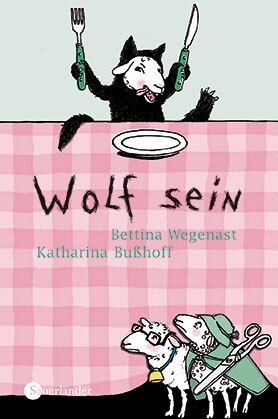Children's Books
Bettina Wegenast
Wolf sein
[Being the wolf]
This book was showcased during the special focus on Chinese (2005 - 2006).
Review
Imagine slipping into a different role and seeing the world from a different perspective. Testing out for once what the grass "really tastes like on the other side of the meadow" and "being really angry just for once". Who has never wanted to do something different or be something different? Being a Wolf, a story that initially started life as a play for the theatre, centres around precisely this wish, simultanously asking how true friendship expresses itself.
Kalle the sheep is a powerful young chap. When the wolf dies, the opportunity arises to step into his wolfish shoes. Kalle trots off to the job centre to apply, and is given the job. But he's barely slipped on the wolf's skin when he starts to change before the very eyes of his friend Locke, adapting to the role of the flesh-eating alpha animal with shocking radidity. He orders his friend Locke around, and even eats Locke's friend René, a bright and gentle sheep who shares his meadow with them.
But that signals the end of his friendship with Locke. Locke takes a large hunting knife and slits Kalle's stomach open, enabling him to rescue René. The latter, however, turns out to be most conciliatory, and doesn't want any serious revenge. In the happy conclusion, the three remember the good points about being a sheep and, together, they return the the wolf's skin.
Bettina Wegenast tells this story of the "sheep in wolf's clothing" with a good dose of humour and many suble allusions. You can often still sense the play behind the story. The gritty dialogue could be lifted straight from the conversations of teenagers: it's slangy and feisty and gives the story its pace and dynamism. There's no space for ennui in this dense plot: it is driven forward by the rapid succession of events. Indeed, the story lives by its plot: every thought is either said or carried out so that it's comprehensible even to the very youngest readers.
Meanwhile, older children or adults reading aloud are entertained by a whole wealth of background allusions. The best of these has to be the scene in the job centre which is run by one of the seven dwarves. He impresses several times upon Kalle that he's "by no means the only applicant" for the job before musing aloud: "The probation period for being a wolf ... ah, I've got it! Probation period for a wolf ... well .. how about until the day after tomorrow? That should be enough to see whether you're up to the job."
The fact that turning yourself into someone else isn't always as straightforward as it is for Kalle is demonstrated when Locke has to adopt the role of hunter and slit open the wolf's stomach. He simply can't kid himself that the supposed wolf is in fact anything but his friend Kalle. He manages to get over this only by desperately talking himself into feeling bold: "Right, I'm the hunter. I'm the hunter!" he spurs himself on. "This thing here - that's just a filthy old wolf..." Together, Locke and René put a heavy stone into Kalle's stomach, but only in fact "...because that's what you do." In the end, though, the knowledge of what they have done weighs more heavily upon them than the demands of storybook tradition, and so they take the stone out and exchange it for a little bell which Kalle will have to carry around with him for the rest of his life (well, he can't go entirely unpunished). Kalle, the most avid hater of bell sheep!
Friendship is the second big theme of this story. After all, harmless Locke allows his friendship with Kalle to tempt him into acting as the "right-hand paw" of the supposed "evil wolf." His trust in his friend Kalle is only destroyed when the latter proves to him in cold blood that he really can be evil. Locke does, however, act on his new insights: he remembers his own values and saves René.
The whole book is beautifully produced with illustrations by Katharina Bußhoff, whose black-and-white drawings perfectly complement and illustrate the text. The pictures take up the bottom third of every page, thus providing a constant accompaniment to the story. With simple, expressive strokes the artist clearly shows both Kalle's badness and Locke's naivety. The way she depicts the exterior of the job centre and the official's room is, moreover, simply brilliant. And as the whole story ends happily ever after, you can breathe a sigh of relief when it's finished - having learnt a bit more about the important things in life!


